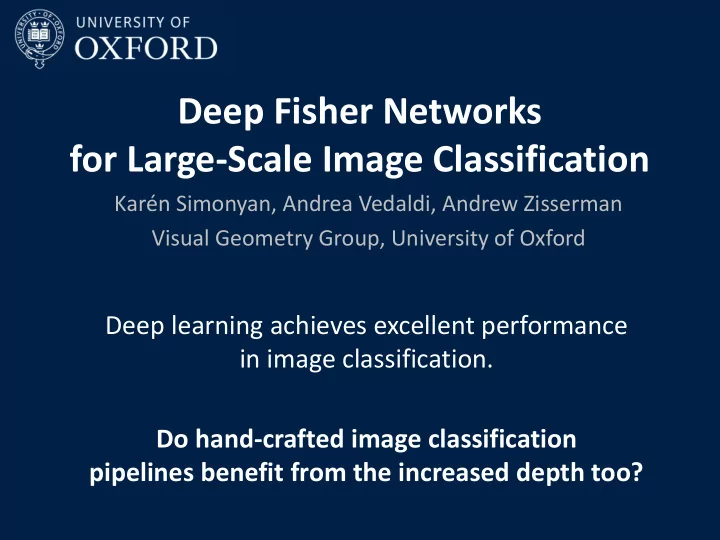

Deep Fisher Networks for Large-Scale Image Classification Karén Simonyan, Andrea Vedaldi, Andrew Zisserman Visual Geometry Group, University of Oxford Deep learning achieves excellent performance in image classification. Do hand-crafted image classification pipelines benefit from the increased depth too?
Image Classification Architectures soft-max linear SVM global fully grouping connected layer Fisher encoder ... fully local linear SVM connected grouping layer global dim. grouping reduction ... Fisher Fisher convolution encoder encoder layer ... local local features features convolution (SIFT) (SIFT) layer Deep Shallow Deep Fisher ConvNet Fisher Vector Network
Deep Fisher Network linear SVM Why Fisher encoding? global • High-dimensional non-linear grouping representation with small Fisher feature codebooks encoder • Outperforms other encodings local feature location (bag-of-words, sparse coding) grouping w.r.t. GMM codebook dim. reduction Fisher FisherNet encoder • Multiple Fisher layers made feasible by local discriminative dimensionality reduction features • SIFT & colour features + 2 Fisher layers (SIFT) • Learning: 2-3 days on 200 CPU cores Deep Fisher (MATLAB + MEX implementation) Network
Large-Scale Image Classification ImageNet challenge dataset: • 1.2M images, 1K classes • top-5 classification accuracy Method 2010 challenge 2012 challenge FV encoding 76.4% 72.7% Deep FishNet 79.2% 76.6% Deep ConvNet 83.0% 81.8% [Krizhevsky et al., 2012] 83.6% (5 ConvNets) Deep ConvNet (our implement.) 83.2% 82.3% Deep FishNet & Deep ConvNet 85.6% 84.7%
Recommend
More recommend